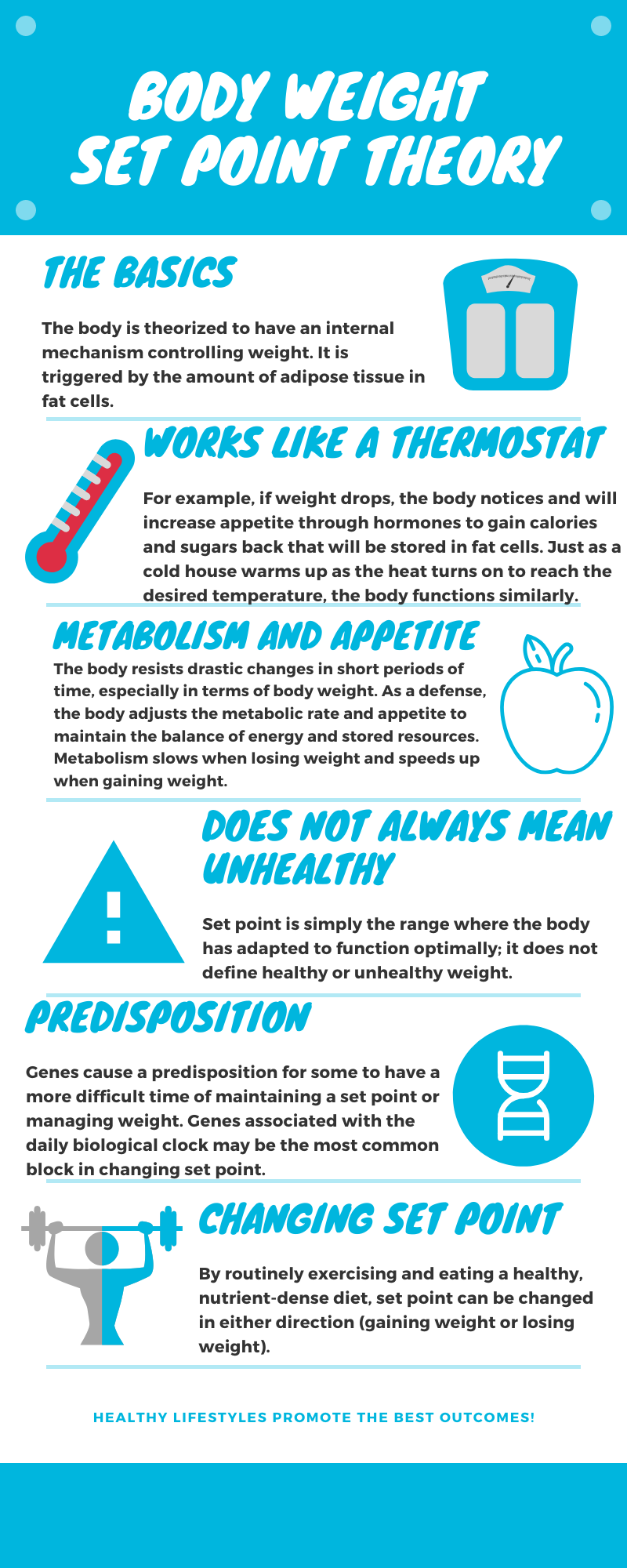3 Bodyweight Set Point Theory
Drew Belsha
The Theory
The bodyweight set point theory is a complex idea supported by thorough research. It is one of the most widely supported theories concerning bodyweight. The theory bases itself on the body having an internal mechanism that regulates weight. The mechanism works around a set point that is triggered by the amount of adipose tissue in fat cells or the size of the fat cells at that time. The mechanism may increase or decrease body functions such as appetite to maintain the current weight within a small percentage range. This theory may be compared to a house thermostat for simpler understanding; when weight drops, the body will notice like a thermostat and increase the release of hormones that promote hunger to gain calories and sugars for fat stores (Hoeger et al., 2019). This gets weight back to the previous level such as a thermostat does for a cold house by turning on the heat to the desired temperature. Fat cells are very active in determining set point and play a role in maintaining body weight (Konigorski et al., 2019). Having more fat cells and higher adipose tissue concentration leads to the release of more hormones and poses an increased risk of disease in the individual.
Set point theory is not describing a healthy weight versus unhealthy weight. Instead, it is defining the range where the body will want to retain bodyweight to function at its prime. Set point may change, although it will require sustained behavior change. Set point theory also describes the challenge associated with trying to lose or gain weight as the body naturally fights these change attempts.
How Set Point is Determined
Research studies have explored how and when an individual’s set point is determined. Set point can be changed, but there may be a genetic link to being predisposed for being over or underweight.
Data from pregnant women’s diets helped researchers form a hypothesis on when set point is predisposed. While developing in the mother, an offspring’s brain centers that control hunger are formed. If a mother overeats or under eats, an effect may be seen in the baby (Hall & Guo, 2017). A pregnant mother may be where set point has its origins. Although, once the baby is in the world, the modern diet begins posing a risk to maintaining the set point. The modern diet is defined as food intake high in calories and fat.
Numerous genes have a relationship with weight management; one that was studied also plays a role in an individual’s circadian rhythm or their daily biological clock. The gene of interest makes losing weight more difficult and increases the chances of being obese (Lo et al., 2018). Knowing if an individual has the gene or not may help in creating the best course of treatment for losing weight. Genes do pose a challenge when attempting to lose or gain weight if they are fighting in opposition, but it is not impossible to overcome. Choosing the right diet and exercise plan depends on the individual and their particular body and its mechanisms.

Changing the Set Point
The biggest question surrounding set point involves how to change the optimum bodyweight for better health outcomes. The modern diet may be to blame for the difficulty in changing set point. Fast food and highly processed foods are the major contributors to the high intake of calories and fat. Lifestyles have also changed to be more sedentary than active, adding another obstacle to obtaining changes in bodyweight set point.
The safest and healthiest way to change set point requires exercise and eating complex carbohydrates and other nutrient-dense foods (Hoeger et al, 2019). Examples of complex carbs include whole-wheat products, quinoa, oats, and sweet potatoes. More information on nutrient-dense foods can be found in the Food and Calories chapter. Weight change needs a calorie increase or calorie decrease to occur. This demands a personal choice to be made to change eating and exercise behaviors. Environmental barriers such as work schedules or no easy access to a gym could be overcome through resources such as internet-based information on better food choices or exercise routines that do not require equipment. Individuals should listen and take advice from health care providers to prevent health issues concerning weight and excessive fat intake (Seaman, 2013).
Medical intervention to change the body’s weight set point is a hot topic of research. Studies on animals have been conducted with promising results; a medication that acts like a natural chemical made in the body was found to reduce the bodyweight set point (Liao et al., 2020). As research progresses, this could be an option for medically controlling set point.
Summary
Bodyweight set point theory is an important concept to understand when it comes to health. It explains why individuals tend to maintain weight or are not able to make changes in the short term. To make changes to weight, long term intervention of a healthy diet and exercise are required. Genes have been studied to influence set point and how heritable traits may have an impact on weight.
Set point theory is not making a distinction between healthy and unhealthy weight, it is the theory of how the body resists change to continue functioning without major changes to its metabolic balance. Individuals should not feel discouraged after learning about set point theory, but instead understand why quick-fix diets and exercise regimens do not always produce desired results. Obtaining medical advice from a health care professional is suggested when considering weight changes.
Check out the infographic below to get a recap of this important theory.

Review Questions
1. What triggers the set point mechanism that affects weight?
a. Genetics
b. Metabolism
c. Amount of fat cells in body
d. Hunger
2. What are the long term interventions to change set point?
a. Exercise
b. Diet rich in complex carbs
c. Medical intervention
d. A & B
3. What is the “modern diet” described as?
a. High calories and high fat
b. Foods that are trending
c. High carb and protein
d. Low calorie diet
References
Hall, K. & Guo, J. (2017). Obesity energetics: body weight regulation and the effects of diet composition. Gastroenterology, 152(7), 1718-1727. https://doi.org/10.1053/j.gastro.2017.01.052
Hoeger, W., Hoeger, S., Fawson, A., & Hoeger, C. (2019). Principles and labs for fitness and wellness. Cengage.
Konigorski, S., Janke, J., Drogan, D., Bergmann, M. M., Hierholzer, J., Kaaks, R., Boeing, H., & Pischon, T. (2019). Prediction of circulating adipokine levels based on body fat compartments and adipose tissue gene expression. Obesity Facts, 12(6), 590-605. doi: 10.1159/000502117
Liao, T., Zhang, S.-L., Yuan, X., Mo, W. Q., Wei, F., Zhao, S.N., Yang, W., Liu, H., & Rong, X. (2020). Liraglutide lowers body weight set point in DIO rats and its relationship with hypothalamic microglia activation. Obesity: A Research Journal, 28(1), 122-131. doi: 10.1002/oby.22666
Lo, M. T., Bandin, C., Yang, H. W., Scheer, F., Hu, K., & Garaulet, M. (2018). CLOCK 3111T/C genetic variant influences the daily rhythm of autonomic nervous function: relevance to body weight control. International Journal of Obesity, 42(2), 190-197. https://doi.org/10.1038/ijo.2017.168
Seaman D. R. (2013). Weight gain as a consequence of living a modern lifestyle: a discussion of barriers to effective weight control and how to overcome them. Journal of Chiropractic Humanities, 20(1), 27–35. https://doi.org/10.1016/j.echu.2013.08.001
connective tissue in which fat is stored and which has the cells distended by droplets of fat
to make susceptible
a tentative assumption made in order to draw out and test its logical or empirical consequences
doing or requiring much sitting
a food (such as rice or pasta) composed primarily of such polysaccharides

